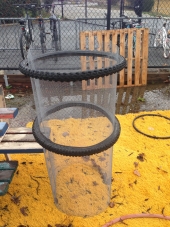
















whitish grey "threads" like a giant web, all over the leaves.




 1
1




So the mushrooms would not come from the mycelium right?
 1
1

















Triato Vallejos wrote:Molds are fungi reproducing ´´asexually´´, they extend microscopic filaments that produce asexual spores at the top. Mooshrooms are produced when two diferent mycelium ´´individuals´´ with diferent genetic makeup meet, conect their hyphae (like fusing) and from the conection generate a mooshroom fruiting body. A fungus species may exist both as a mold and as a mooshroom, but for some species only one of the forms is known. For example: Metarrizium is an insect patogen mold that under certain conditions is also the cordiceps mooshroom, its mycelium can generate both the mold and the mooshroom, Paul Stamets talks a lot about that species.
Just to clarify, mycelium is the filament (hyphae) ´´web´´, it can exist in many forms and density. It is like fungus tisue, all reproduction structures grow from mycelium.





|
Scaramouche. Scaramouche. A tiny ad dressed as a clown.
Learn Permaculture through a little hard work
https://wheaton-labs.com/bootcamp
|


